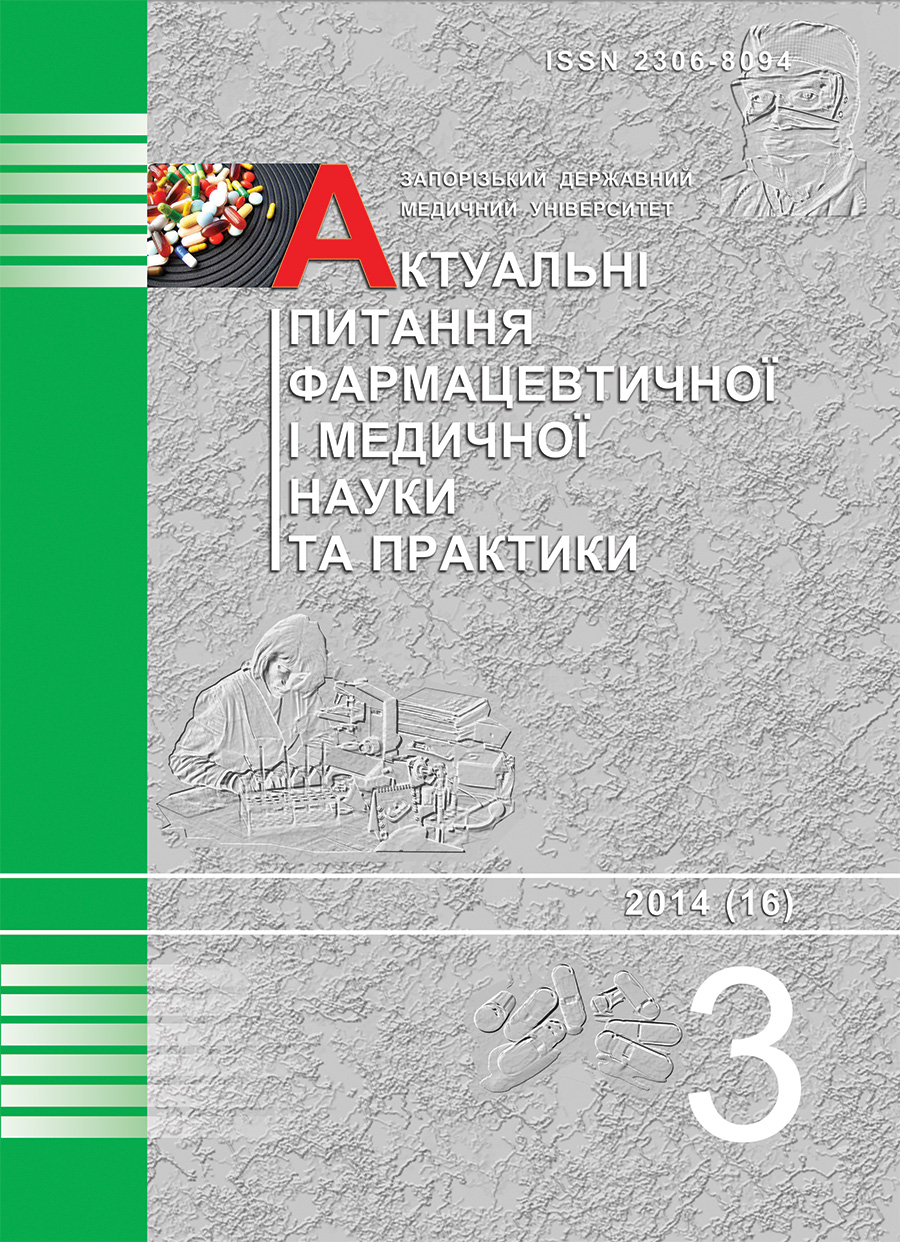Comparative pharmacokinetic study of dosage forms with morpholinium 2-[5-(pyridin-4-yl)-1,2,4-triazol-3-ylthio] acetate
DOI:
https://doi.org/10.14739/2409-2932.2014.3.33211Keywords:
Morpholinium 2-[5-(pyridin-4-yl)-1, 2, 4-triazol-3-ylthio] Acetate, Absorption, Eliminative Behavior, BioavailabilityAbstract
Using mathematical models of income distribution and excretion of drugs greatly enhances the interpretation of the results of biopharmaceutical research. Pharmacokinetic modeling makes it possible to quantify the biological assessment of pharmaceutical factors, opens the possibility of a science-based regulation of the kinetics of substances introduced through targeted changesof pharmaceutical factors. Results of the study of kinetic models are used to solve some practical problems associated with pharmacological and clinical trials of medicines.
Morpholinium 2-[5-(pyridin-4-yl)-1,2,4-triazol-3-ylthio] acetate is new organic compound from the 1,2,4-triazole group obtained at the Department of Inorganic Chemistry, Zaporozhye State Medical University. The substance has antioxidant and anti-ischemic action, low toxicity.
Aim of this work is to study the kinetics of absorption of morpholinium 2-[5-(pyridin-4-yl)-1,2,4-triazol-3-ylthio] acetate developed formulations.
MATERIALS AND METHODS
Pharmacokinetic studies of oral and rectal dosage forms of morpholinium 2-[5-(pyridin-4-yl)-1,2,4-triazol-3-ylthio] acetate was performed on Chinchilla rabbits weighing an average of 2.5 kg, divided into three groups. The third group for comparison was administered a 1% injectable solution of morpholinium 2-[5-(pyridin-4-yl)-1,2,4-triazol-3-ylthio] acetate intravenously. Substance dose was 0.1 g and 0.5 g per kg of animal body weight, which were administered once. Sampling from the auricular vein of the rabbits was performed at 5, 10, 15, 30, 45, 60, 75, 90, 120, 150 and 180 minutes after oral administration and rectal dosage forms of morpholinium 2-[5-(pyridin-4-yl)-1,2,4-triazol-3-ylthio] acetate and after 3, 5, 10, 15, 20, 30, 40, 50 and 60 minutes after intravenous injection. Morpholinium 2-[5-(pyridin-4-yl)-1,2,4-triazol-3-ylthio] acetate concentration in serum was adjusted spectrophotometrically.
Results.Morpholinium 2-[5-(pyridin-4-yl)-1,2,4-triazol-3-ylthio] acetate elimination from the body of the animal occurs within 1 hour, and then only trace amount of the drug substanceis detected in serum. After oral and rectal dosage forms of morpholinium 2-[5-(pyridin-4-yl)-1,2,4-triazol-3-ylthio] acetate its maximum concentration in the blood of laboratory animals is recorded at 60 minutes after administration of the capsules and suppositories respectively. Thereafter, for 2-2, 5 it is supported at a high level. At the same time, no significant differences in the kinetics of the drug administered dose. 24 hours after single oral administration and rectal capsules and suppositories of morpholinium 2-[5-(pyridin-4-yl)-1,2,4-triazol-3-ylthio] acetate is not detected in the serum.
Comparative analysis of the pharmacokinetics of morpholinium 2-[5-(pyridin-4-yl)-1,2,4-triazol-3-ylthio] acetate depending on the kind of administration and the dosage form shows that after oral administration in capsule form, and rectal administration as a suppository absorption rate constants, elimination, half-life periods floor suction and depending on the dose administered differ slightly. Also, almost no relationship between dose and orally administered rectally morpholinium 2-[5-(pyridin-4-yl)-1,2,4-triazol-3-ylthio] acetate and total quantities (of plasma) clearance, since the difference between the drug administered in doses of 5 times the value of the latter increased only 1.2 times. Degree of morpholinium 2-[5-(pyridin-4-yl)-1,2,4-triazol-3-ylthio] acetate absolute bioavailability after oral and rectal administration, is practically independent from the dose. The magnitude of this indicator for rectal suppository almost 3 times higher than that for oral capsules of morpholinium 2-[5-(pyridin-4-yl)-1,2,4-triazol-3-ylthio] acetate. This indicates the great promise of his rectal dosage form.
Conclusion. The degree of its absolute bioavailability for rectal dosage form doesn’t depend on administered dose and is nearly twice higher than for the oral solid gelatin capsules with morpholinium 2-[5-(pyridin-4-yl) -1,2,4-triazolo 3-ylthio] acetate.
References
Smith, D. A., Allerton, C., & Kalgutkar, A. S. (2005) Pharmacokinetics and metabolism in drug design. Weinheim : Wiley-Verlag GmbH&Co. KgaA.
Shargel, L., Pong, S., & Yu, A. B. (2005).Applied biopharmaceutics & pharmacokinetics (5th ed.). New York: Appleton & Lange Reviews/McGraw-Hill, Medical Pub. Division.
Chadova, L. V., Rysukhina, N. V., Panasenko, O. I. Knysh, Ye. H., Kaplaushenko, A. H., Lukianchuk, V. D. (2008). Patent Ukrainy na vynakhіd №37927 Morfolіnіi 2-(5-(4-pіridil)-4-(2-metoksifenіl)-1,2,4-triazol-3-іltіo)acetat, shho proiavliaie antyoksydantnu і de-toksykuiuchu aktyvnostі; zajavl. 28.07.2008; opubl. 10.12.2008. Biul., 23. [in Ukrainian].
Kaplaushenko, A. H., Parchenko, V. V., Knysh, Ye. H., Pavlov, S. V., Shcherbyna, R. O., et al. (2012) Patent Ukrainy na vynakhіd №76334 Zastosuvannia morfolіnіiu 2-(5-(4-pіridil)-4-(2-metoksifenіl)-1,2,4-triazol-3-іltіo)acetatu abo pіperidinіiu 2-(5-(furan-2-іl)-4-fenіl-1,2,4-triazol-3-іltіo)acetatu yak neirotropnykh agentіv; zajavl. 08.09.2010; opubl. 25.12.2012. Biul., 24. [in Ukrainian].
Belousov, Yu. B. & Gurevich, K. G. (2006) Klinicheskaya farmakokinetika. Praktika dozirovaniya lekarstv. [Clinical pharmacokinetics. The practice of drug delivery]. Moscow: Feniks. [in Russian].
Downloads
How to Cite
Issue
Section
License
Authors who publish with this journal retain copyright and grant the journal right of first publication with the work simultaneously licensed under a Creative Commons Attribution License that allows others to share the work with an acknowledgement of the work's authorship and initial publication in this journal.


